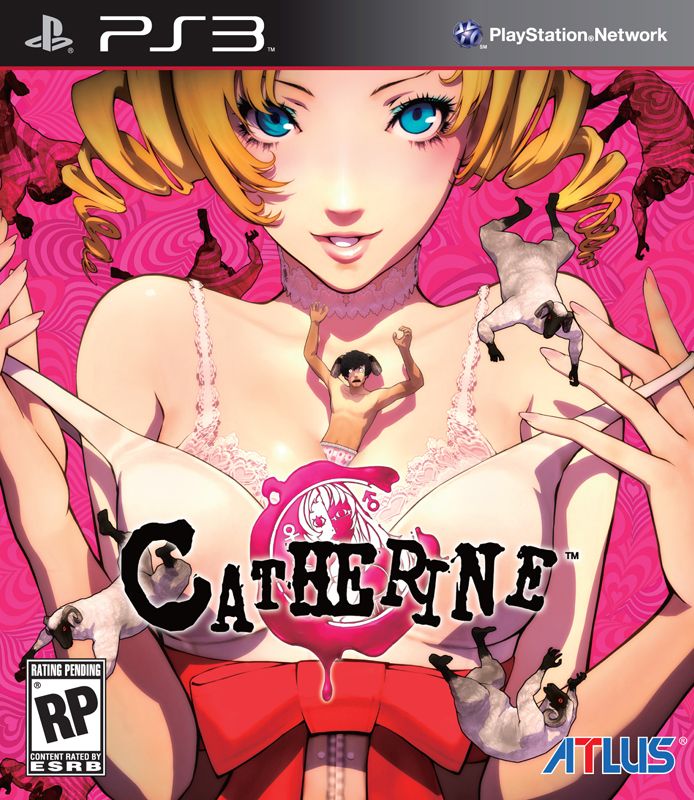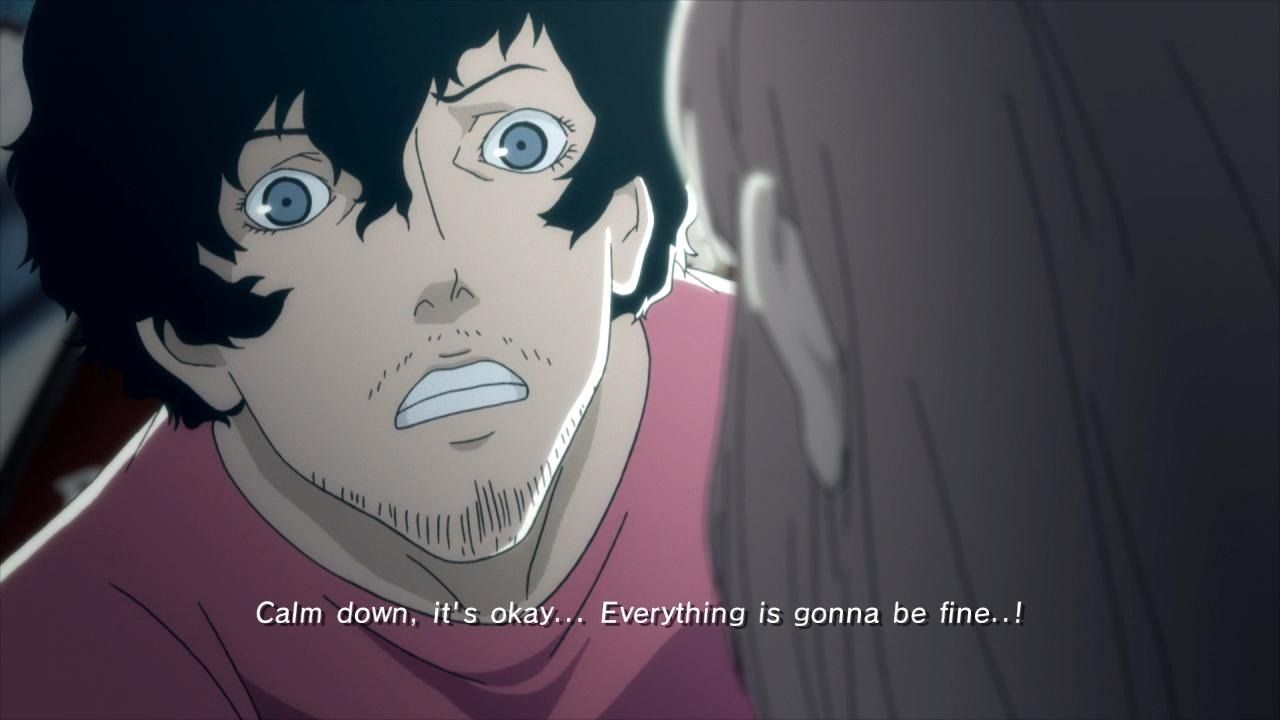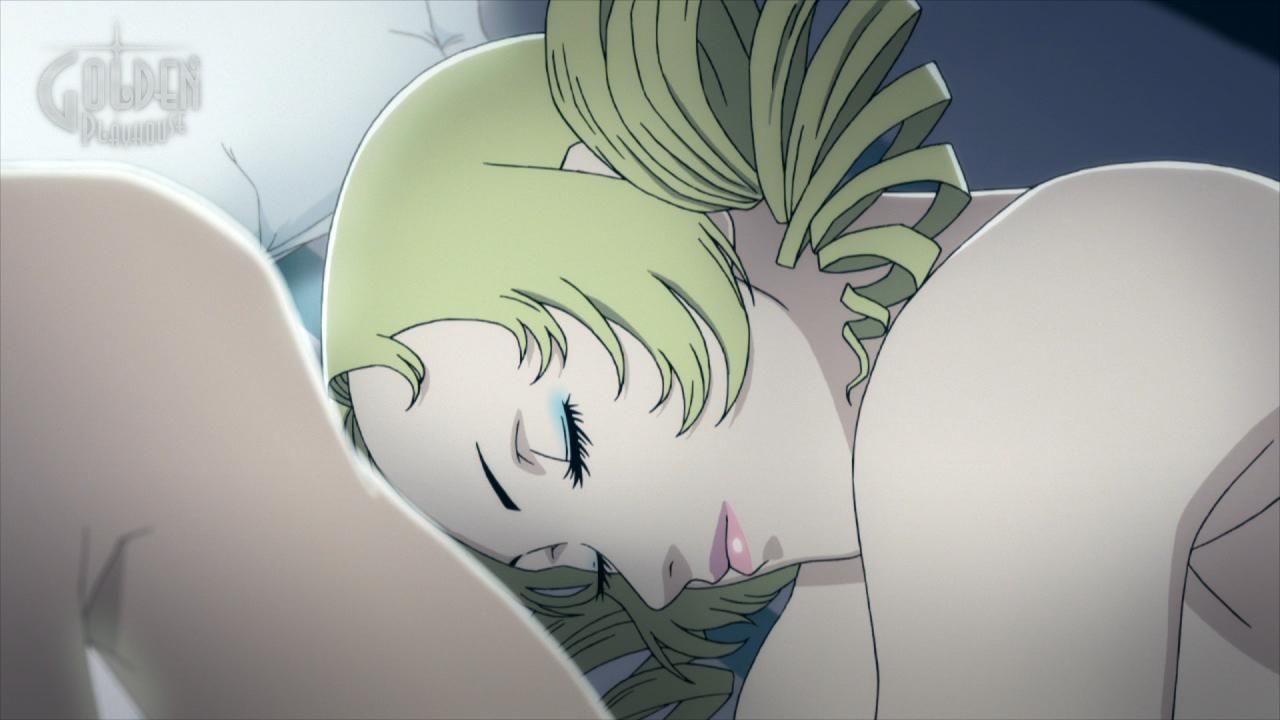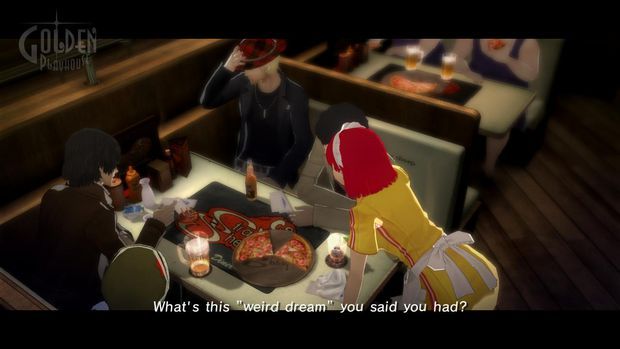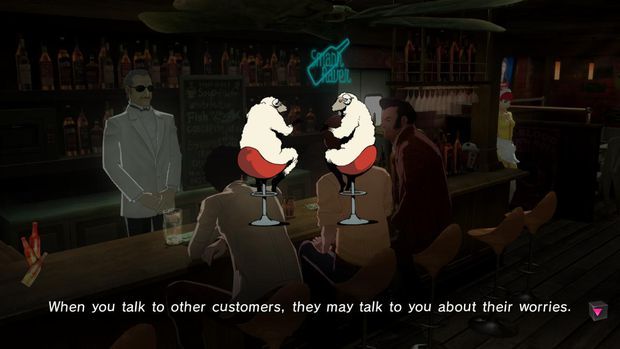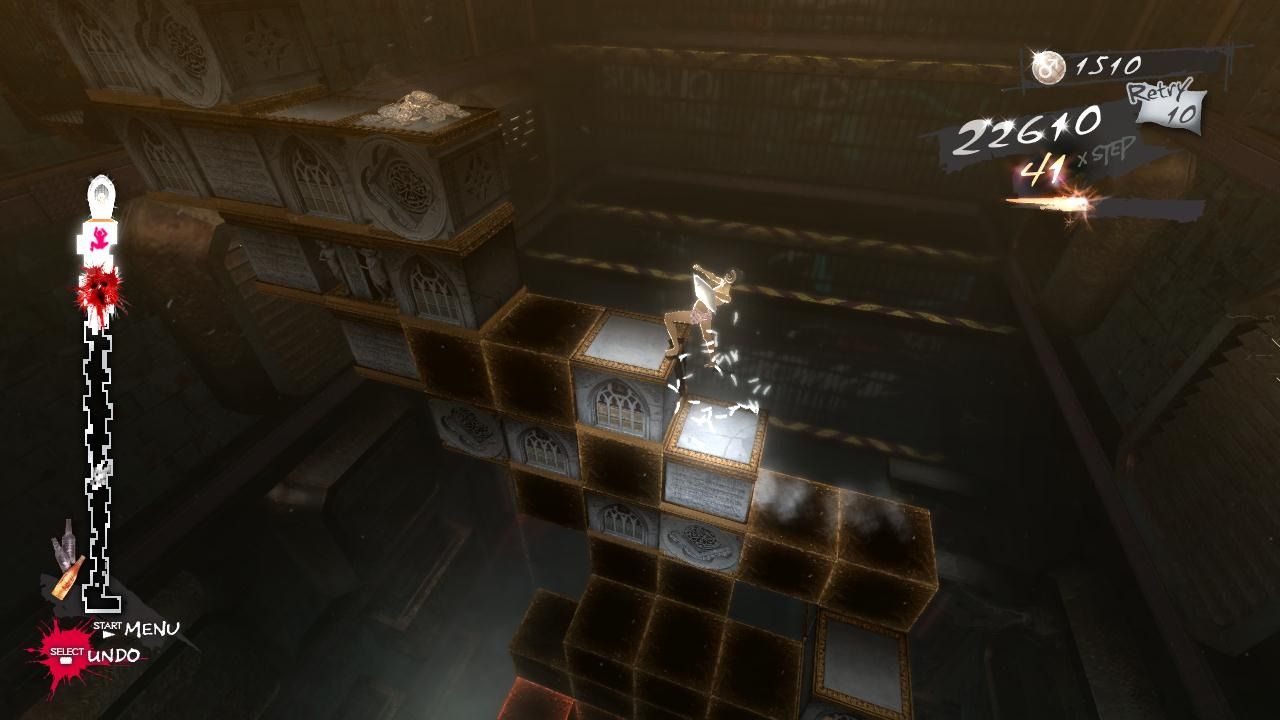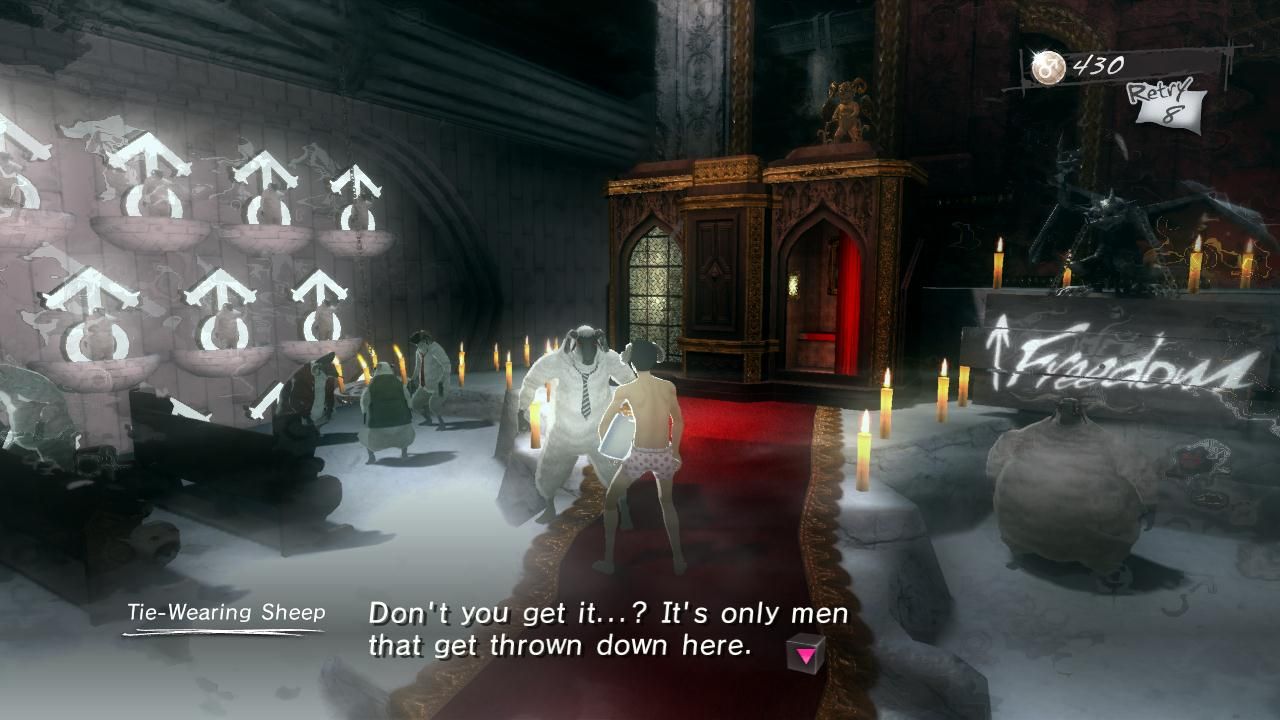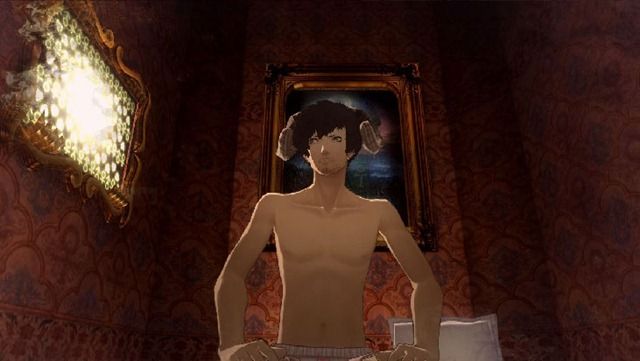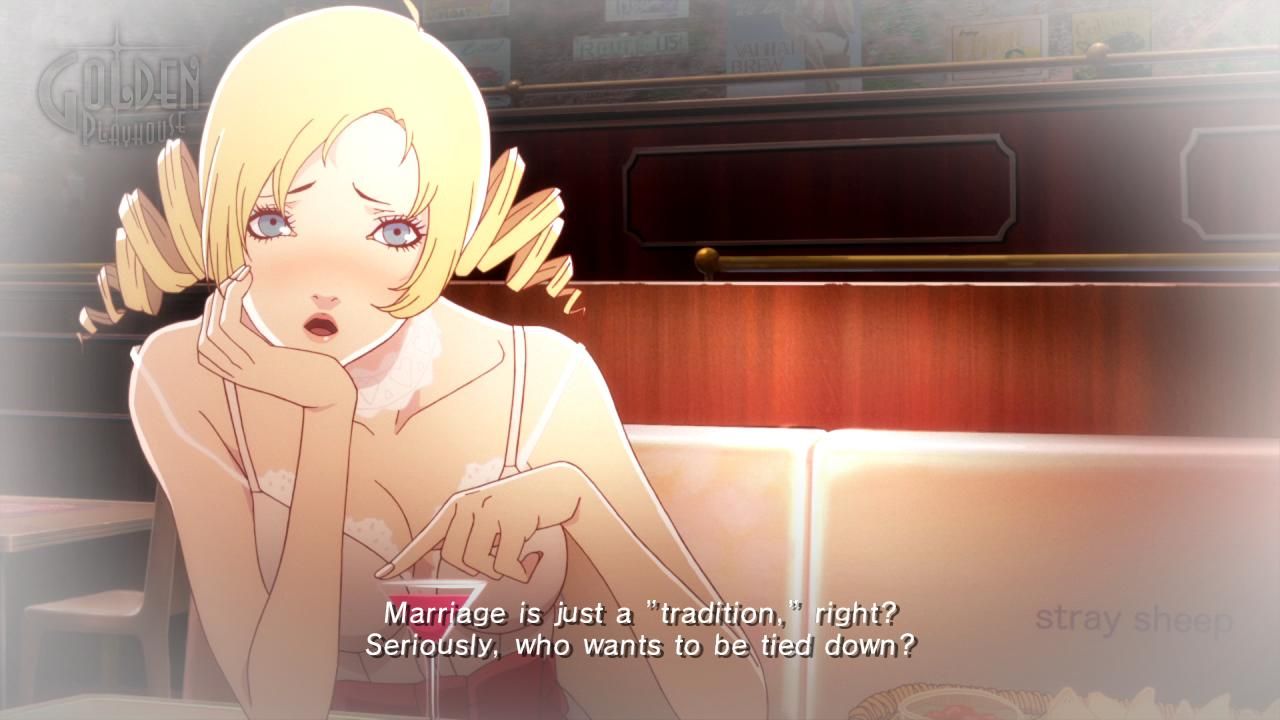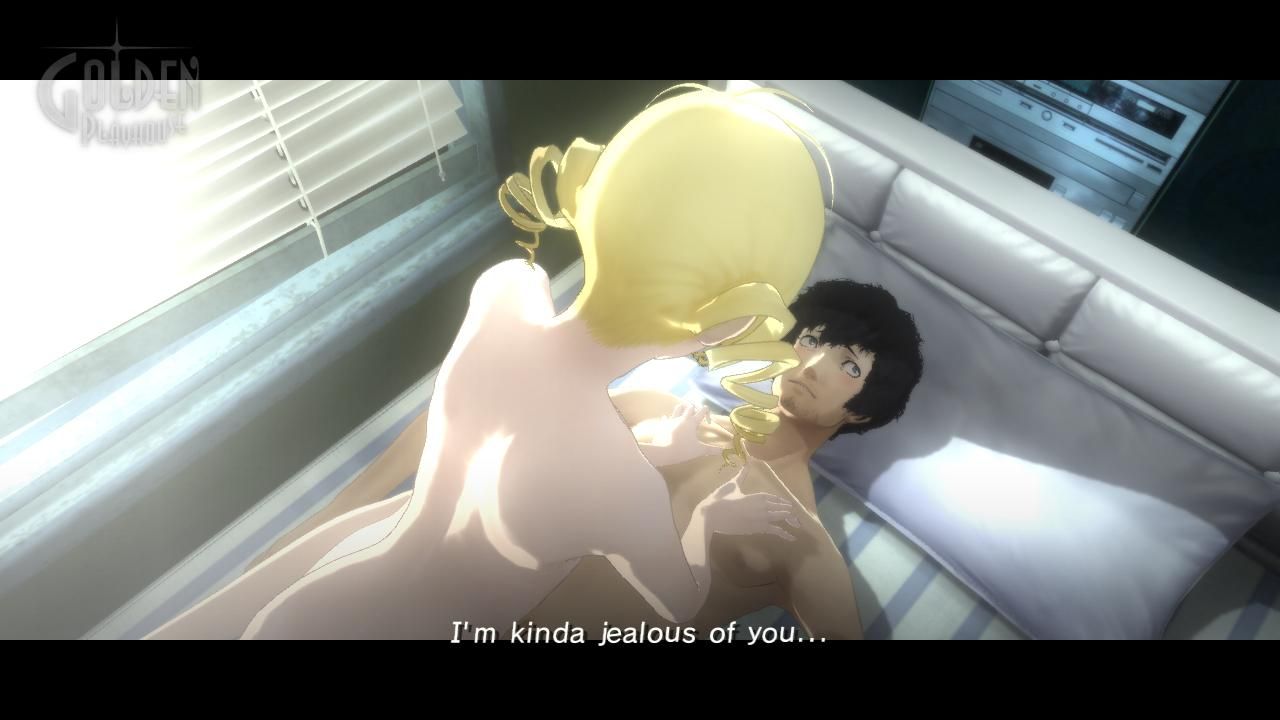One of the hardest things about writing a review isn’t playing the actual game, it’s figuring out how to translate that experience into words, especially the introduction and the conclusion of said review. Catherine makes this process even more difficult because, for the first time in a while, I’m actually lost for words. It’s not a great feeling when someone who writes as much as I do can’t come up with words to describe the experience he just had.
When something so different, so off the wall, so…mature comes our way, sometimes we don’t know what to do with it, considering the amount of gratuitous game content that gets passed off as “mature material” these days. What Atlus did with Catherine is nothing short of redefining what a game can be, the emotions that can be conveyed in a game and the way a game can make you think. But, to start everything off, I just want to say one thing: Catherine is not, in any way, shape or form, a sex game.
Contrary to what the Atlus Japan marketing campaign would have us believe, this isn’t a game about sex. Surprised? If you are, you should maybe start ignoring marketing hype. Atlus USA was a bit less focused on the over-the-top character of Catherine and more content to let the game’s content speak for itself, which is a great thing.
Catherine tells the story of Vincent, a 30-something man unsure of which direction his life will lead next. He’s in a relationship with his long-time girlfriend Katherine, and she has seriously been wanting to take their romance to the next level – marriage. Vincent isn’t sure what to think about this, as he’s comfortable the way things are. To throw a monkey-wrench into things, another woman, Catherine, introduces herself to Vincent in a rather full-frontal manner and, from that point on, things start spinning out of control for the poor dude.
About the time he starts receiving visits from Catherine, he starts having nightmares where he’s portrayed as a sheep and forced to climb a seemingly insurmountable stairway of movable blocks each night. If he doesn’t climb, he’ll die. Naturally, Catherine and these nightmares are related, but how? That’s the basic plot the story spins and the main question that is likely going to be on everyone’s mind within the first hour of gameplay.
To add more depth to the story, the game seems to bring up more questions along the way and is very stingy on answers. Should Vincent tie the knot with Katherine or remain in his comfort zone? How does he go about telling Katherine – if he even should – that he was unwillingly thrust into some form of relationship with a younger woman? Is cheating the end of all things, or does life continue afterward? How will the girls respond to the various signals he’s sending? Trust me, that’s just the tip of the iceberg for Vincent. As much as you want to feel sorry for Vincent to some degree, he’s still a huge idiot. You get a sense, while playing through the game, that Vincent is one of the most pathetic humans on the planet, in more ways than one.
What I enjoyed was the very distinct and deliberate juxtaposition between the two girls. Katherine, the more reserved (unless you piss her off), mature, yet somewhat nagging steady girlfriend, and Catherine, the young, shiny-boobed (see image above), mysterious blonde who acts like nothing short of a creepy nympho, showing up in Vincent’s room during the night unannounced, parading around in either nothing at all or in nothing but a shirt.
Vincent’s problem is that he really wants Catherine, but is probably scared that Katherine will remove his manly parts if he so much as thinks of cheating on her. Your job, as the player, is to direct Vincent in the direction you’d like him to go and you do this through answers to various questions throughout the game (I’ll touch on this later) and in how you respond to the girls when they interact with you via text messages.
I’ll be honest here, I’m a goody-two-shoe, and attempted as much as possible to steer Vincent in the right direction, even though at times Katherine made me wonder why. She’s easily angered from Vincent’s indecision and she scares me more than the creepy blonde chick who shows up in Vincent’s bedroom each night.
All this is an attempt to explain, as best I can, how the developers try to manipulate the player. Aside from the aforementioned differences, Katherine seems very muted throughout the game. She wears darker colors, is more business-like, tends to be quieter and more contemplative (again, unless Vincent pisses her off, which he does a lot because he’s an idiot). Catherine, on the other hand, is thrown in your face – she wears suggestive outfits (or, you know, nothing at all), plays to Vincent’s likes, flashes her boobs all over the place and just generally wins hands-down for Vincent and the players’ attention, as if saying, “I’m here, choose me and you’ll never have a dull night in your life!”
So, there is a choice there and it seemed to me the proverbial carrot is being dangled in front of the donkey in that the “right” decision is to resist the temptation, yet it is still ever-present, constantly pressing you into breaking and just going with the flow and giving in to your desires.
In addition to all that, the brilliance of the plot is that the characters are believable – it could be you, me or anyone we know in any of these positions. Vincent is an ordinary guy (albeit, again, an idiot) who goes to the bar to have a drink and hang out with friends, spends lunch time talking to friends, has fears and emotions just like us. All this is where the true cleaverness of this game lies. Even the girls – both Katherine and Catherine – are realistic and show great emotion, range and depth throughout the entirety of the game. Granted, most of these men you meet at the bar and during the course of the game seem to be the lowest scumbags on the face of the planet, but still - how many people like this do you think are out there for real? My point exactly.
The game is presented in three segments, which follow the same order: Story cut scenes, spending time in the bar and the nightmare stages. Rinse, repeat. Let’s take a look at all three in order.
The main story is presented in both full-on anime cut scenes and game-rendered scenes, with full voice acting and great animation. I’m always a fan of Team Persona’s work, the character designs and animation, as well as the overall cinematic feel and production design. It always draws you into the setting and the characters lives and makes you feel right at home. There are some lengthy cut scenes, and the only downside here is you can’t save in the middle of them (you can pause and skip, however, but who would want to?). The only issue I have here is the drastic difference in sound volume between the anime scenes and the in-game scenes. When I set my volume at a comfortable level for the in-game scenes (which vastly outnumber the anime segments), my eardrums get blasted away when it switches to an anime scene, and I have to manually drop the volume down, only to have to raise it again when that part is over.
Still, I’m blown away by the quality of the animation and the great voice work present here. The only downside to the voices is that of the tutorial narrator, which I feel is a bit forced and pretty bland. Otherwise, great voice acting all around. The music is awesome, as usual. It reminds me heavily of Persona titles, with good reason. You can even unlock some Persona music on the jukebox in the Stray Sheep bar. Speaking of which...
After you spend the time progressing the story in the cut scenes, there’s always a segment at your “home base”, so to speak - the Stray Sheep bar. Each night Vincent ends up there before going home to sleep. There are a plethora of things to do here. For starters, you always have access to your phone. This is your route to saving the game, as well as interacting with both girls. As they send you text messages, you can respond based on your feelings, with various choices and outcomes. These messages are basically your way of directing the flow of Vincent's mind - does he lean more toward having an affair with a hot, young blonde or sticking with his comfortable and steady long-time girlfriend?
Here you can also talk to the bar’s patrons, and each time you have a conversation, time passes. In this manner, people cycle in and out, change the topic of conversations and it all really makes you feel like you’re there in person, watching the goings-on of a typical night in such an establishment. The great thing is that, unlike previous games from this same development team, you have no maximum time limit – you can see and do everything there is to do each night without worry that you’ll cause too much time to pass and automatically be ferried off to your bed.
Here you can also get Vincent to drink. There are three levels of drunkenness he can have, and the more he drinks the faster he moves in the nightmare stages that follow. What I especially like here is, after you’re done with one drink you can order another of your choice, and each time you finish a glass, you’re presented with some facts about the particular drink you just downed. That’s pretty cool and a nice side activity to check out while spending time at the bar. There are even four trophies associated with this activity – one for seeing all facts for each type of beverage.
You’ll also have a jukebox available, which you can access to change the background music at the bar. It includes songs that are unlocked through various in-game activities and accomplishments – including original songs from Catherine, and songs from previous Atlus titles, like I mentioned a moment ago. There’s also an arcade game you can play, call Rapunzel. It’s an 8-bit recreation of the nightmare stages you visit with Vincent, except you don’t have a time limit, but, instead, are limited to a certain number of moves. Progressing in Rapunzel unlocks new songs for the jukebox and other non-mandatory game features and items.
Finally, there’s a restroom you can go into in the bar, where you can catch a glimpse of the area of the nightmare you’ll be traversing that night. You’re also given a bit of privacy while in the stall where you can view the special images Catherine tends to send your way on your phone.
All this translates into a lot of things to do, see and hear at the Stray Sheep bar, and it adds a real grounding element to the whole surreal nightmare impetus that is put on the more action-oriented stages of the game. I always liked going and talking to the waitress, Erica, because many times she has some snappy sarcastic remark to make about men in general (and dresses like Ronald McDonald). Many patrons have more than one thing to say, and you can talk to them two or three times, even. When you’re ready to head on home, walk out the door.
At this point things usually jump to the nightmare stage – where the game’s action lies and is, in my opinion, the least engaging part of the title. But, when I say “least engaging”, it’s all relative, because there is still plenty of depth and fun to be had in the frantic pursuit of higher ground.
Most nightmare stages consist of two to four levels, broken up by a safe platform where you can talk to other men trapped in the same situation – represented as sheep. Also, most levels have at least one checkpoint roughly half-way through the climb. Generally they’re placed pretty well. Sometimes they’re closer to the top before a particularly tricky part of the ascent. The final level of each stage can be compared to a boss fight, since those are the levels where Vincent’s nightmares manifest themselves into some form of monster that is also chasing him up this column of blocks, thus heightening the pace as which you need to move and adding more and more complex variations to the maneuvers you have to perform to make it safely to your destination.
I feel these nightmare stages are pretty well done overall. They make the player think without making things overly difficult. Don’t get me wrong, though, there are certain places that are just plain tough, especially if you need to play around to figure out which is the most efficient (or only) way to rearrange the blocks so as to progress upward. From about stage three onward, there’s also a gimmick for each stage that throws yet another monkey wrench into the proceedings. On one stage it may be booby trap blocks that shoot out spikes a second after you hop on them, and on another it may be ice blocks that force you to slide over the top of them if you make a wrong move. Keep in mind, there is no health bar – this game is full of one-hit kills. Any time you slip up, you’re dead.
As you progress, all these gimmicks get added together for lethal combinations of obstacles, almost to the point of driving you insane. Like I mentioned, there is quite a bit of inherent difficulty here just in the level design, but I feel that most of the challenge comes from having to constantly multitask. You always have to think about what kinds of blocks you have around you, what danger may be in them and which manner to shuffle them so as to get the desired effect. On more than one occasion I hopped onto a booby trap block without even thinking and lingered too long, thus getting killed with spikes. I’ve also trapped myself on a section of blocks that was about to get rattled by an exploding block. Once more and more gimmick blocks get added to the mix, you’re trying to think of so many things at once that the inevitable mix-up happens quite frequently.
On top of that, the controls, to me, feel a tad bit too touchy. You almost have to resort to using the D-pad to control Vincent, so you can attempt to be more precise in his movements. If you go a bit too far pushing or pulling a block, you might not be able to complete the stairway you were working on, or you might slide onto that ice block that will take you over the edge to your death.
I’m not particularly fond of the gimmick on each stage, I would have preferred the stages be built in such a way that you’re thinking strictly about building the staircase instead of how each type of block will react to Vincent. But, on easy and normal difficulties, at least, it never gets to the point where you’re retrying a level dozens of times. I would have to say that the difficulty is just about right for normal playthroughs. Sure, you’re going to die, there’s no doubt about it, but continues are plentiful and you can pick up pillows along the way to add to that number.
On the safe platforms between stage levels, you can chat up the other sheep trying to stay alive. With them you can share techniques that can help you on your trek. Eventually you’ll have some, “Oh yeah!” moments when you match up various sheep in the nightmare to people you meet in the real world, and things start clicking. Although, I find it a bit odd that nearly every guy you meet in the real world is somehow connected to this nightmare. During your climb, you can pick up coins places throughout on various blocks, which can be spent to purchase items at merchants who sometimes show up on these rest areas.
Items can also be found scattered about on the way up, and many of them come in handy, even though you can only carry one at a time. What I liked about this was that there really are only a few items, but they all have a specific purpose and they all are lifesavers. This is much better than having dozens of different items only to make one or two of them really, truly helpful. The most helpful the majority of the time is extra block, which allows you to create and place a block anywhere you want, and the energy drink, which lets you climb two blocks at once. Something important to note, though, is that, while these items are helpful, it was very obvious to me that the stages are perfectly manageable without them, because I didn’t use them a whole lot myself.
Once you reach the top of each level, your score is calculated and you get a bronze, silver or gold trophy based on how well you did during your climb. This doesn’t affect the story or gameplay at all, but always gives you something to shoot for. Still, you have to go through several levels sometimes to reach the top and progress to the next day, or story segment. When you’re ready to leave the safe platform between levels, you’ll enter a confession booth and be asked a question from a mysterious voice, then be ferried off to the next level.
I have to say, some of these questions really make you think, and I love the way they were worded. Also, the voice seems to always react in such a way that you never know what is the “best” answer. There really is no right or wrong choices, as the game progresses either way, but there is a meter that reacts to your decisions in-game and dialog and some story elements are based off of the direction that meter leans toward (angel or devil, good or bad, I assume). What’s also pretty nifty is, if you’re connected to Xbox Live or the PSN, you’ll get to see a chart showing the conglomeration of other players’ first choices to that very question – and the way some questions lean may surprise you.
In addition to the main story of the game – titled the Golden Theater – there are multiplayer co-op levels, as well, where you can either work together with a friend to climb to the top of various stages, or work against them and try not to be the one who gets pushed off the staircase. These extra modes really do add some playability to the title, but ultimately fall far flat of what you can experience in the Golden Theater mode. They almost seem like an afterthought that didn’t really need to be there, but the good thing is that they don’t detract from the main game at all, because the quality of the story mode is still there in spades. The one thing they are good for, however, is to heighten your skills of climbing the nightmare stages, which you’ll really need if you are masochistic enough to go through the game on the higher difficulties.
If you take all three of the Golden Theater sections and combine them into one wonderful medley of unique gaming goodness, Catherine adds up to a title that is about so much more than just killing people, trying to get the highest score or level up your character. Catherine delves into the human mind, and paints a wildly dark picture of what our minds can create and how it can shape our world - which is a very real, very visceral feeling not many titles can produce. When you're playing a shooter, or an RPG, your mind is typically in one place - killing other people or leveling up to progress the story. None of that exists here - you're presented with a world and characters that are believable, down to earth and exploding with human flaws and frailties just like you and I.
While these sort of games tend to teeter on the edge of being critical hits, but not economically viable, they are the games that will be remembered. When I think of great, unique, memorable games of the last couple years, I think of Heavy Rain, L.A. Noire and, now, Catherine. I don't think of your shooter-of-the-year, that next mediocre super hero game or the latest Final Fantasy remake. That's some high praise for a game many of us thought would never make it outside of Japan. You really have to play Catherine to understand it, and I really hope everyone who considers themselves a gamer would take the time to understand what it means for a game to be something more substantial than the sum of its parts.
Sure, there are a few flaws, most notably in the nightmare portions where things, at times, may seem cheap and riddled with trial-and-error bits, but once you learn how things work in Vincent's nightmare world, you'll be spurred to action and be concentrating so much on progressing to the next poignant story point that you forget about everything else. The game isn't too long, about 12 hours, but there's so much depth to what you'll find, and it might even help you glimpse something really special. It's unfortunate that the marketing for Catherine in Japan got so many people off-base as far as what this game actually is, and I hope people don't look too much into it and, instead, really give this title a shot. Playing Catherine, you may have literal nightmares for weeks about shifting blocks around, but it's worth it to broaden your gaming vocabulary with this excellent entry into the HD area from a great team of developers.
-
Title: Catherine
- Platform Reviewed: PS3
- Developer: Atlus
- Publisher: Atlus USA
- Release Date: July 26, 2011
- MSRP: $59.99
- Review Copy Info: A copy of this title was provided to DualShockers, Inc. by the publisher for the purpose of this review.

